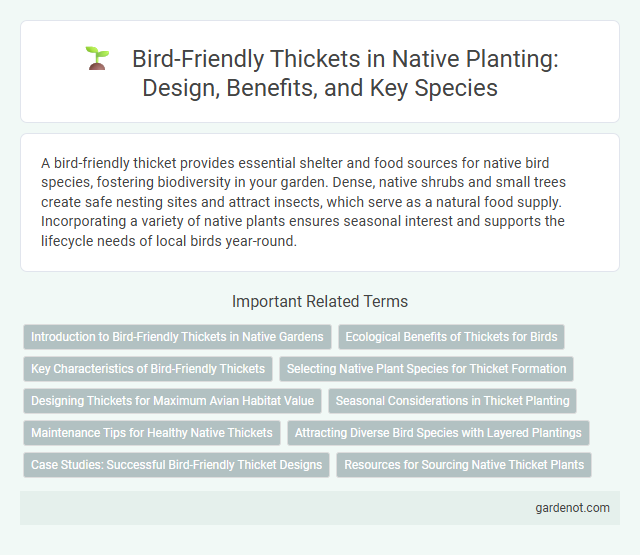A bird-friendly thicket provides essential shelter and food sources for native bird species, fostering biodiversity in your garden. Dense, native shrubs and small trees create safe nesting sites and attract insects, which serve as a natural food supply. Incorporating a variety of native plants ensures seasonal interest and supports the lifecycle needs of local birds year-round.
Introduction to Bird-Friendly Thickets in Native Gardens
Bird-friendly thickets in native gardens provide essential shelter, nesting sites, and food sources for local bird species, enhancing biodiversity. These dense, multi-layered plantings consist of native shrubs, small trees, and ground cover that create safe habitats and attract diverse bird populations. Incorporating bird-friendly thickets supports ecological balance by promoting pollination, insect control, and seed dispersal within the garden ecosystem.
Ecological Benefits of Thickets for Birds
Bird-friendly thickets provide essential shelter and nesting sites, supporting diverse bird populations and enhancing local biodiversity. These dense native plant clusters offer abundant food sources such as insects and berries, promoting healthy bird diets and breeding success. Thickets also create safe corridors for bird movement, reducing predation risks and improving overall ecosystem resilience.
Key Characteristics of Bird-Friendly Thickets
Bird-friendly thickets provide dense, layered vegetation that offers essential cover and nesting sites for various bird species. These thickets predominantly consist of native shrubs and small trees that produce abundant berries, seeds, and insects, serving as critical food sources. The structural diversity in thickets enhances habitat complexity, supporting bird biodiversity and promoting year-round avian shelter.
Selecting Native Plant Species for Thicket Formation
Selecting native plant species such as elderberry, serviceberry, and spicebush ensures robust thicket formation that provides essential shelter and food for local bird populations. These plants offer dense foliage and seasonal berries, fostering a thriving habitat for nesting and foraging birds. Incorporating a diverse mix of shrubs and small trees enhances structural complexity critical for bird-friendly thickets.
Designing Thickets for Maximum Avian Habitat Value
Designing bird-friendly thickets involves selecting a diverse mix of native shrubs, trees, and ground covers that provide year-round shelter, nesting sites, and abundant food sources such as berries, seeds, and insects. Incorporating various plant heights and densities creates layered habitat structure essential for different bird species, enhancing protection from predators and harsh weather. Strategic placement near water sources and migration corridors further maximizes avian habitat value and supports local biodiversity.
Seasonal Considerations in Thicket Planting
Seasonal considerations in bird-friendly thicket planting ensure optimal habitat and food availability throughout the year. Selecting native shrubs and trees with staggered bloom times and fruit ripening supports diverse bird species during breeding, migration, and winter months. Timing planting to coincide with local rainfall patterns enhances establishment success and long-term thicket health.
Maintenance Tips for Healthy Native Thickets
Prune native shrubs regularly to promote dense growth and improve airflow, reducing the risk of disease in bird-friendly thickets. Mulch around the base with organic materials to conserve moisture and suppress weeds, supporting root health. Monitor for invasive species and remove them promptly to maintain native plant biodiversity essential for attracting and sustaining local bird populations.
Attracting Diverse Bird Species with Layered Plantings
Layered plantings in bird-friendly thickets provide diverse habitats that attract a wide range of bird species by offering varied food sources, shelter, and nesting sites. Incorporating native shrubs, small trees, and groundcovers creates structural complexity, supporting birds such as warblers, sparrows, and cardinals throughout the year. This multi-tiered vegetation enhances biodiversity and promotes sustainable ecosystems by meeting the specific needs of different bird species.
Case Studies: Successful Bird-Friendly Thicket Designs
Case studies of successful bird-friendly thicket designs demonstrate the use of native plant species such as serviceberry, elderberry, and spicebush to create dense, layered habitats that provide food, shelter, and nesting sites for local bird populations. Research from conservation projects in the Midwest highlights increased avian diversity and nesting success rates when incorporating structural complexity and seasonal fruiting plants within these thickets. Effective designs integrate native grasses and understory shrubs to support insect populations, essential for feeding nestlings and enhancing overall ecosystem health.
Resources for Sourcing Native Thicket Plants
Sourcing native thicket plants from local native plant nurseries and specialized seed suppliers ensures ecological compatibility and supports regional biodiversity. Utilizing resources such as state native plant societies, native plant databases like the Lady Bird Johnson Wildflower Center, and conservation organizations provides access to region-specific species and propagation guidelines. These sources offer high-quality, genetically appropriate plants that promote bird-friendly habitats by providing essential food, shelter, and nesting sites.
Bird-friendly thicket Infographic

 gardenot.com
gardenot.com